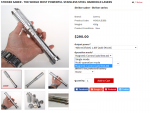- Joined
- Sep 20, 2013
- Messages
- 20,284
- Points
- 113
The diode used to get 800 mW has such a large emitter that it produces a line instead of the dot that the single mode diode does. I have one putting out over 1 watt of power that I built and these highly divergent 638nm laser diodes are very inexpensive. They are likely using a long focal length single element or multi element lens to try to reduce the size of the line, which is why it is only 800 mW instead of a full watt. The single mode diode will give you a nice dot even with a short focal length aspheric lens.
Last edited:





